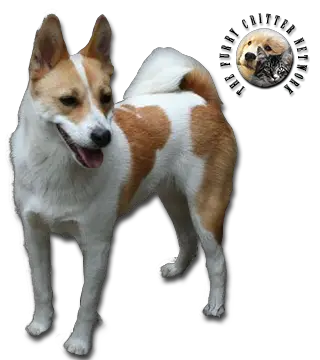Breed Standard
Head: Dry, strong, wedge-shaped. Moderately broad, rather flat skull. Slightly domed forehead. Stop not pronounced. Straight nose bridge. Very pointed muzzle. Fine, dry lips.
Ears: Set on high. Held stiffly erect.
Eyes: Medium size, almond, set obliquely in the skull. Dark color.
Body: Square body outline. Dry neck is carried proudly. Pronounced forechest. Chest is moderately deep. Muscular, slightly sloped croup. Belly is moderately tucked up.
Tail: Set high and carried in a large circle curling loosely over the back with the tip touching the side of the thigh.
Hair: Short, hard, dense. Short hair on the head and front of the legs. Longer on the body, back of the thighs, and under the tail. Fine, dense undercoat.
Coat: All colors permitted. Ideal coat color is a black background with yellow orange markings.
Size: Dog: approx. 45 cm.Bitch: approx. 42 cm.
Weight: Approx. 10 kg.
History
The breed originated in Norrbotten, Sweden and Lappland/Kainuuland, Finland, and have been documented as early as the 17th century. Sweden and Finland argue about the true home of the Norrbottenspets, but clearly the dog has spent much time in both countries. The dogs were mainly used as hunting companions. By the end of World War I, the Norbottenspets came close to extinction. Due to the very small number of norrbottens, Sweden closed its studbook in 1948. Although some dogs were preserved, they were in a non-Swedish speaking area and in the far north as a farm dog and companion. Enthusiasts sought out the few remaining dogs and started a successful breeding program between the 1950s and early 1960s. FCI confirmed a new breed standard in 1966 and the official name was confirmed as Norrbottenspets. In 1967 the Swedish Kennel Club accepted the breed for registration and a new standard was written. Finland accepted the standard and began registering dogs in 1973. In Finland these dogs are called Nordic Spitz. Immigrant farmers have given the dog an even longer name, Norbottens-skollandehund. There is a great effort in Finland to ensure the health of these fox-like hunting dogs and breeding is highly controlled. Healthy animals, that are only distantly related, are being bred with careful consideration of breeding consultants to create a strong background. Sweden has also had a dramatic impact on the preservation of this breed through strict breeding practices.
Behavior
This courageous, lively, hardy breed is very active and has great endurance. It has a balanced personality and is never nervous or aggressive. This affectionate breed gets along well with children. It also makes for a good guard dog.
The Norbottenspets can adapt to life in the city provided it gets long, frequent walks. Regular brushing is required.
Function
Today the majority of Norrbottenspets are kept as pets, but traditionally the breed has been maintained as a hunting dog and general farm dog. The breed is used to hunt a wide variety of game including gamebirds, deer including elk as well as occasionally bear, there are a many stories of Norrbottenspets chasing away bears that have attacked their master. A tireless, determined hunter with a keen nose, many Norrbottenspets have been trained as search and rescue dogs.
Health
This a very healthy and robust breed. No breed specific issues.






